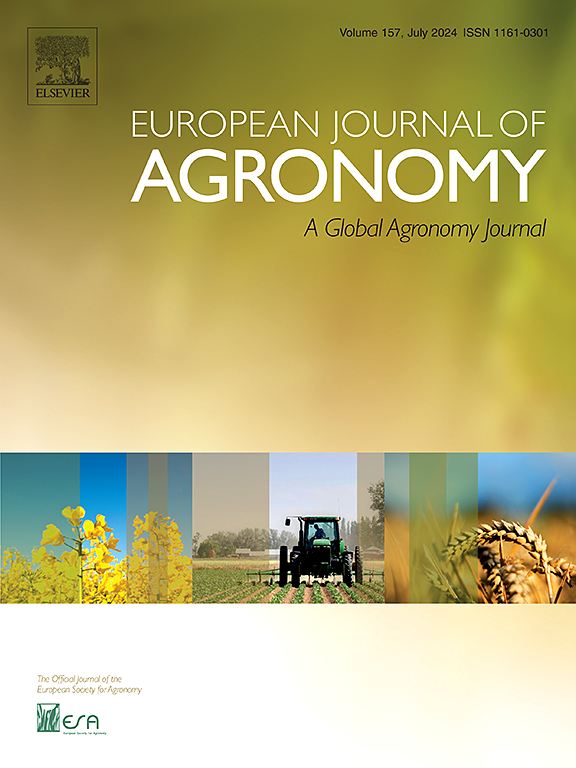Modern maize hybrids have increased grain yield and efficiency tolerances to nitrogen-limited conditions
IF 4.5
1区 农林科学
Q1 AGRONOMY
引用次数: 0
Abstract
Context or problem
Previous studies confirmed continued yield improvements in maize (Zea mays L.) since the introduction of hybrids. However, corresponding yield genetic gains (GGs) and associated physiological changes occurring under low- nitrogen (N) conditions are less understood.
Objective or research question
This study assessed the growth, yield and key trait GGs of 38 non-GMO legacy hybrids under low- (34–99 kg N ha−1) versus high-N (202–280 kg N ha−1) conditions to understand the role of N in trait changes over time.
Methods
Hybrids, commercialized in the USA by Bayer Crop Science from 1983 until 2020, were evaluated in eight site-years N trails at locations across Indiana, Illinois, and Iowa between 2020 and 2022. Seventeen traits were studied pre- and post-anthesis and at physiological maturity. The GGs for each trait are reported as Best Linear Unbiased Predictions (BLUPs), linked to the year of hybrid release.
Results
Grain yield increased by 88 kg ha−1 year−1 under low-N and 102 kg ha−1 year−1 under high-N. Over the past decade, modern hybrids grown under low-N outyielded older hybrids grown under high-N. Despite typical trade-offs between yield and grain N concentration, the grain C:N ratio increased in most recent hybrids subjected to low-N, indicating greater carbon (C) accumulation per unit of plant N uptake. Harvest index (HI) increased similarly under both N conditions, with no sign of a plateauing. Newly released hybrids displayed improved N use efficiency at maturity under low-N, and GGs in biomass accumulation during the post-silking period followed observations of enhanced ear dry weight in newer hybrids at the R2 growth stage.
Conclusions
Breeding for yield indirectly improved maize tolerance to soils with limited available N and enhanced N use efficiency via more grain C capture per unit plant N uptake.
Implication or significance
This study highlights the potential for maize breeders to target specific post-silking traits while simultaneously improving yield and inherent N efficiencies. Furthermore, this research contributes to a deeper understanding of whole-plant N dynamics, and the role of breeding in advancing sustainability. However, future research should also focus on assessing the N rate dependency of GGs in maize hybrids in the context of multiple plant densities or other potential management system interactions.
现代玉米杂交品种提高了籽粒产量和效率,对氮限制条件具有耐受性
背景或问题以往的研究证实,自引入杂交种以来,玉米(Zea mays L.)的产量持续提高。目的或研究问题本研究评估了 38 个非转基因传统杂交种在低氮(34-99 kg N ha-1)和高氮(202-280 kg N ha-1)条件下的生长、产量和关键性状的遗传增益(GGs),以了解氮在性状随时间变化中的作用。方法在 2020 年至 2022 年期间,对拜耳作物科学公司于 1983 年至 2020 年期间在美国商业化的杂交种进行了评估,这些杂交种在印第安纳州、伊利诺伊州和爱荷华州的八个地点进行了为期八年的氮追踪。在花前、花后和生理成熟期对 17 个性状进行了研究。结果在低氮条件下,谷物产量增加了 88 千克/公顷-年-1;在高氮条件下,谷物产量增加了 102 千克/公顷-年-1。在过去十年中,在低氮条件下种植的现代杂交种的产量超过了在高氮条件下种植的老杂交种。尽管产量和谷物氮浓度之间存在典型的权衡,但大多数低氮条件下的最新杂交种的谷物碳氮比有所增加,这表明每单位植物氮吸收量的碳(C)积累量更大。在两种氮条件下,收获指数(HI)都有类似的增长,没有趋于平稳的迹象。结论为提高产量而育种间接提高了玉米对可用氮有限的土壤的耐受性,并通过每单位植株氮吸收量获得更多谷物碳来提高氮的利用效率。此外,这项研究有助于加深对整个植株氮动态以及育种在促进可持续发展方面的作用的理解。不过,未来的研究还应侧重于评估玉米杂交种在多植株密度或其他潜在管理系统相互作用背景下的氮速率依赖性。
本文章由计算机程序翻译,如有差异,请以英文原文为准。
求助全文
约1分钟内获得全文
求助全文
来源期刊

European Journal of Agronomy
农林科学-农艺学
CiteScore
8.30
自引率
7.70%
发文量
187
审稿时长
4.5 months
期刊介绍:
The European Journal of Agronomy, the official journal of the European Society for Agronomy, publishes original research papers reporting experimental and theoretical contributions to field-based agronomy and crop science. The journal will consider research at the field level for agricultural, horticultural and tree crops, that uses comprehensive and explanatory approaches. The EJA covers the following topics:
crop physiology
crop production and management including irrigation, fertilization and soil management
agroclimatology and modelling
plant-soil relationships
crop quality and post-harvest physiology
farming and cropping systems
agroecosystems and the environment
crop-weed interactions and management
organic farming
horticultural crops
papers from the European Society for Agronomy bi-annual meetings
In determining the suitability of submitted articles for publication, particular scrutiny is placed on the degree of novelty and significance of the research and the extent to which it adds to existing knowledge in agronomy.
 求助内容:
求助内容: 应助结果提醒方式:
应助结果提醒方式:


